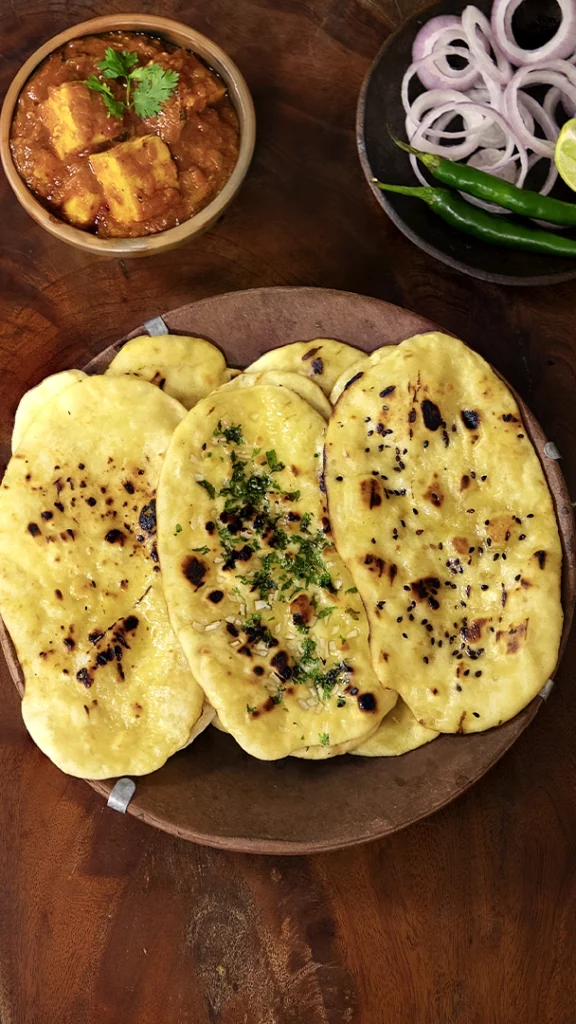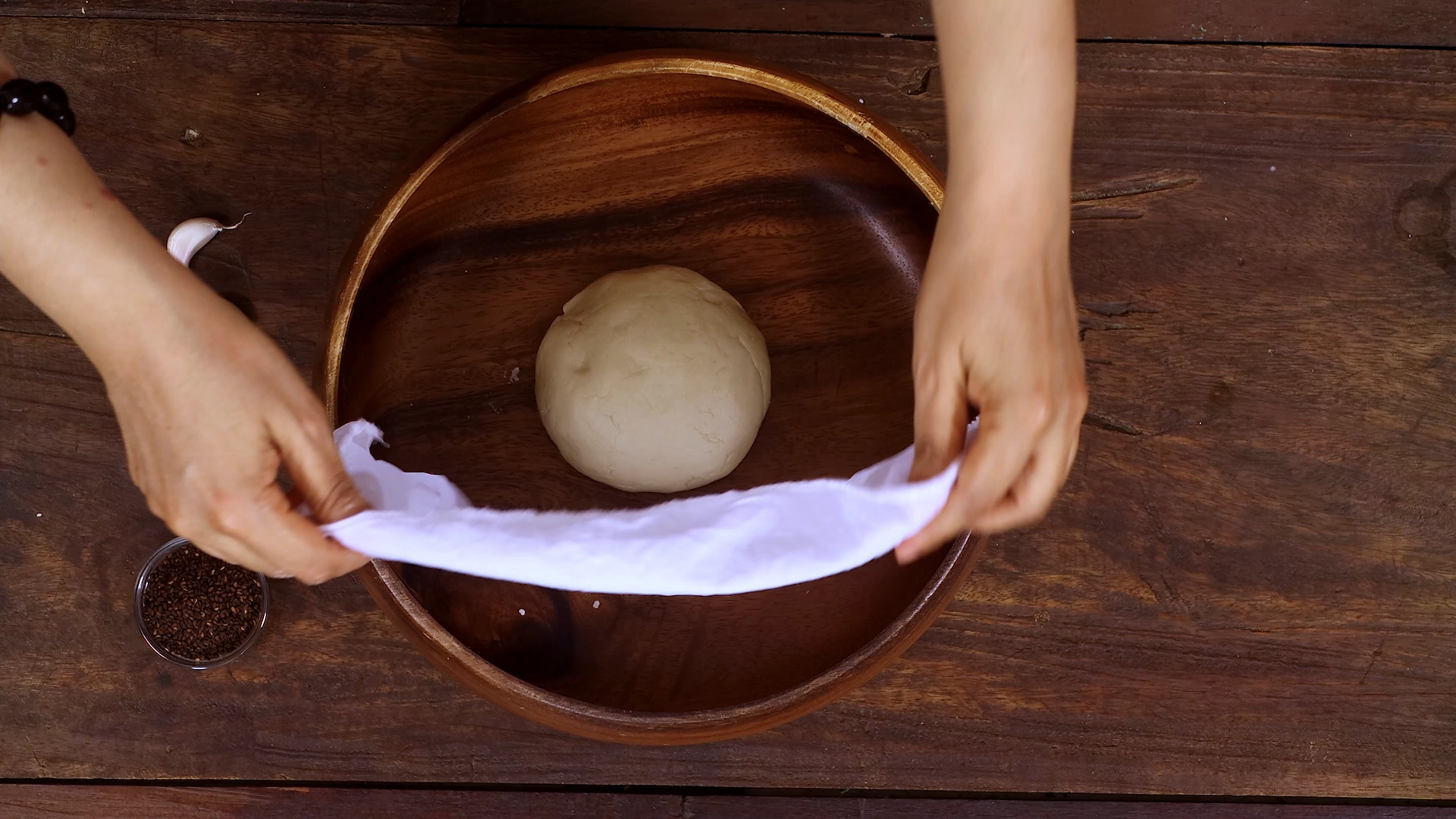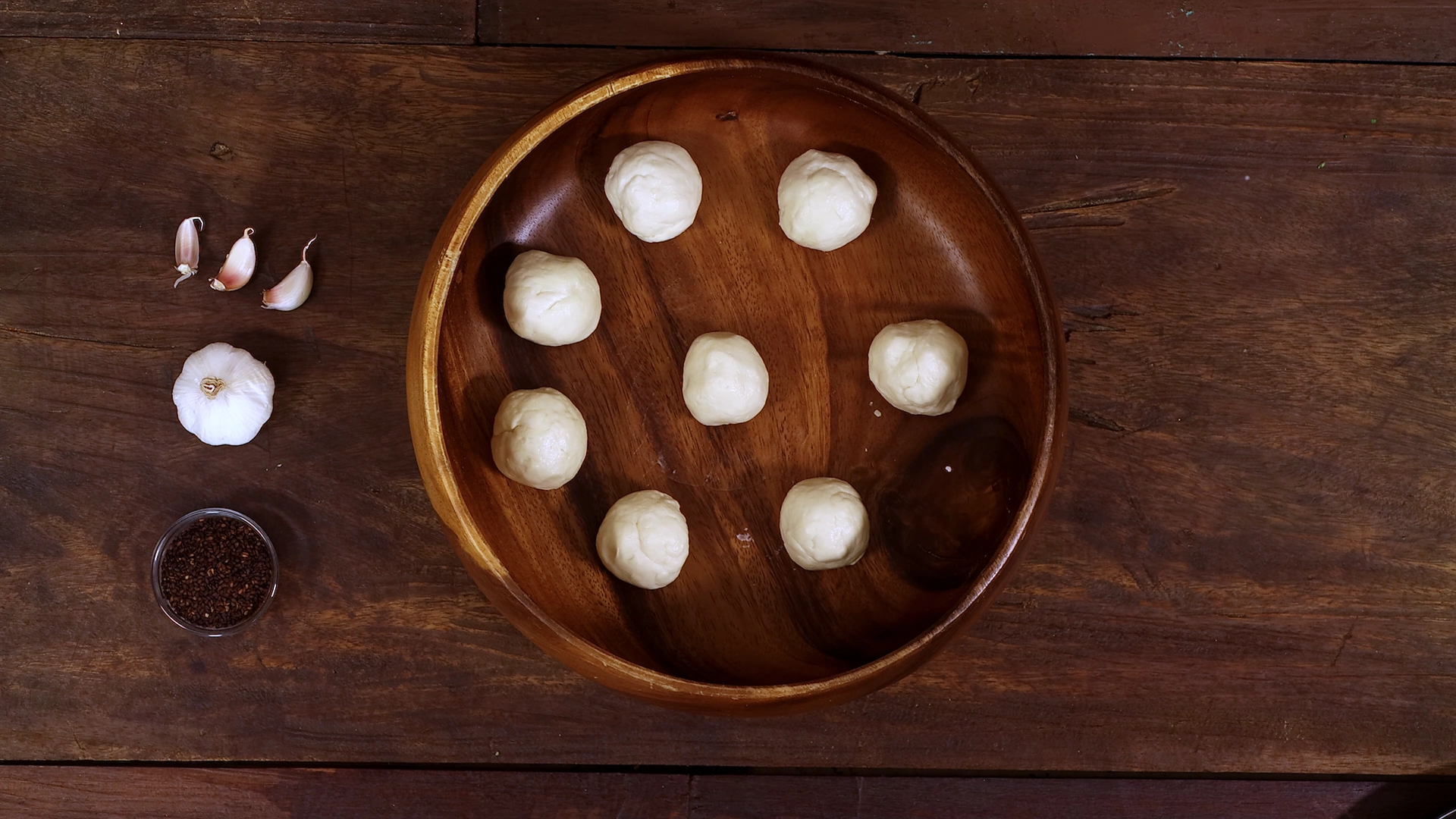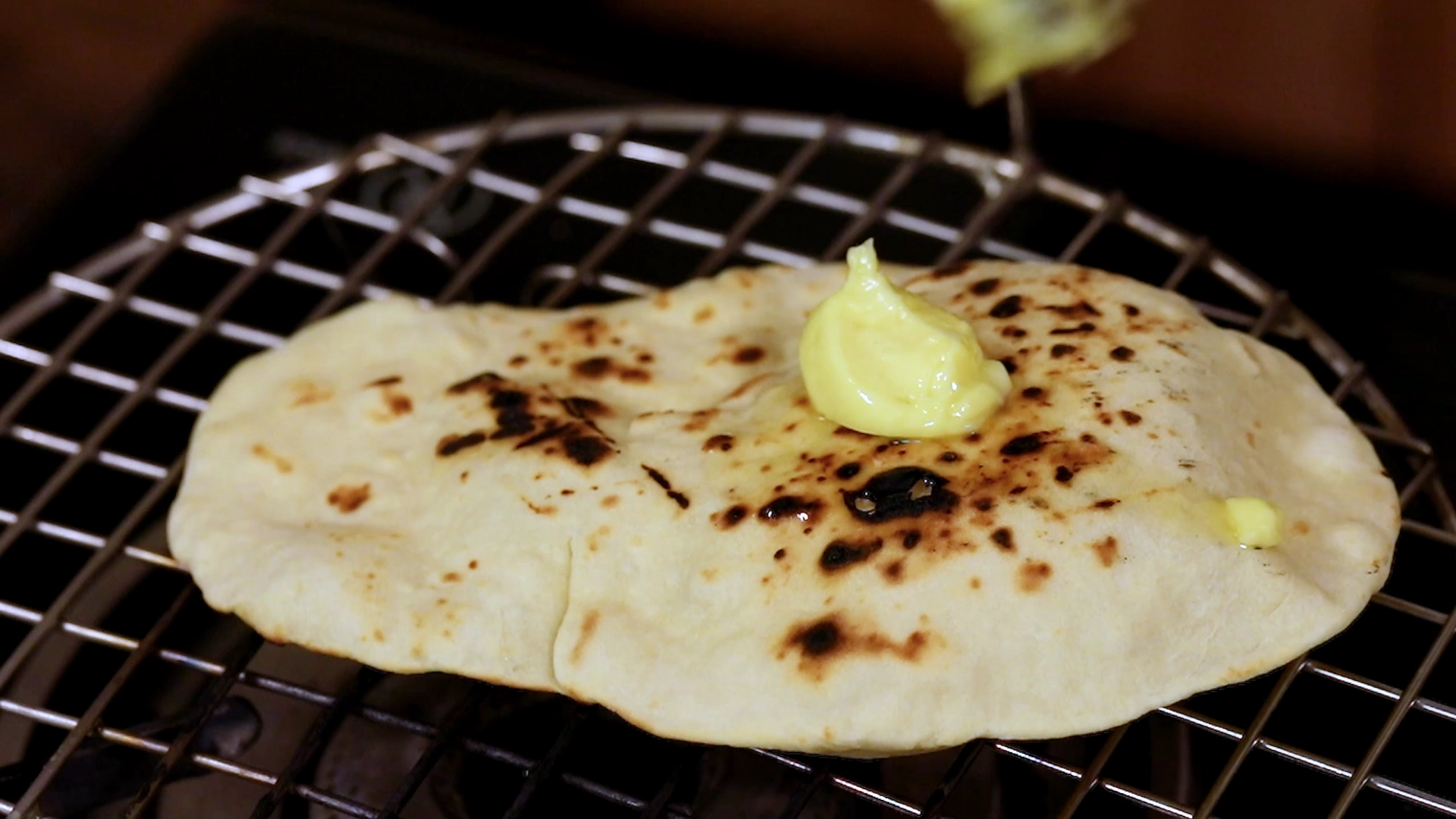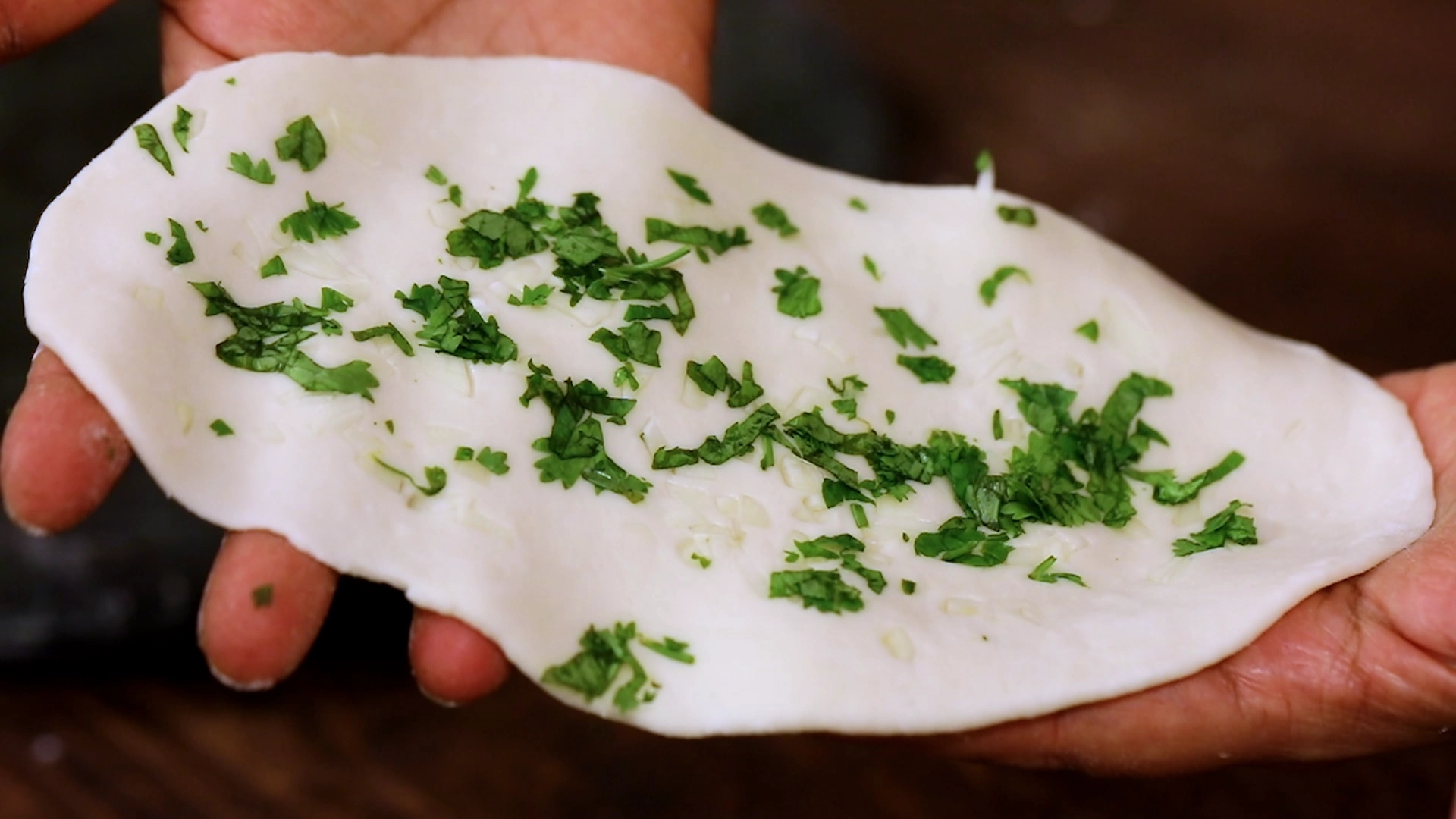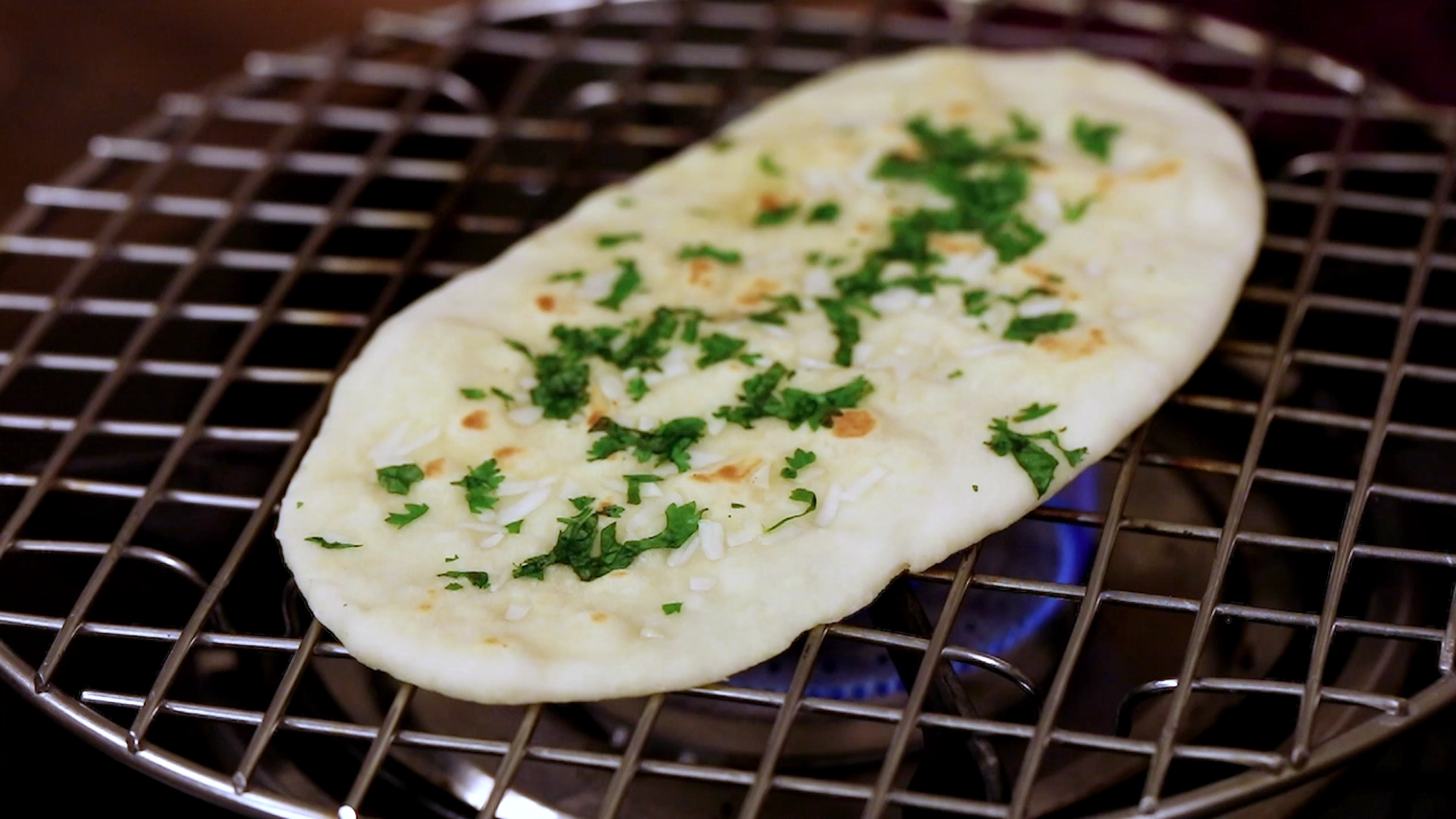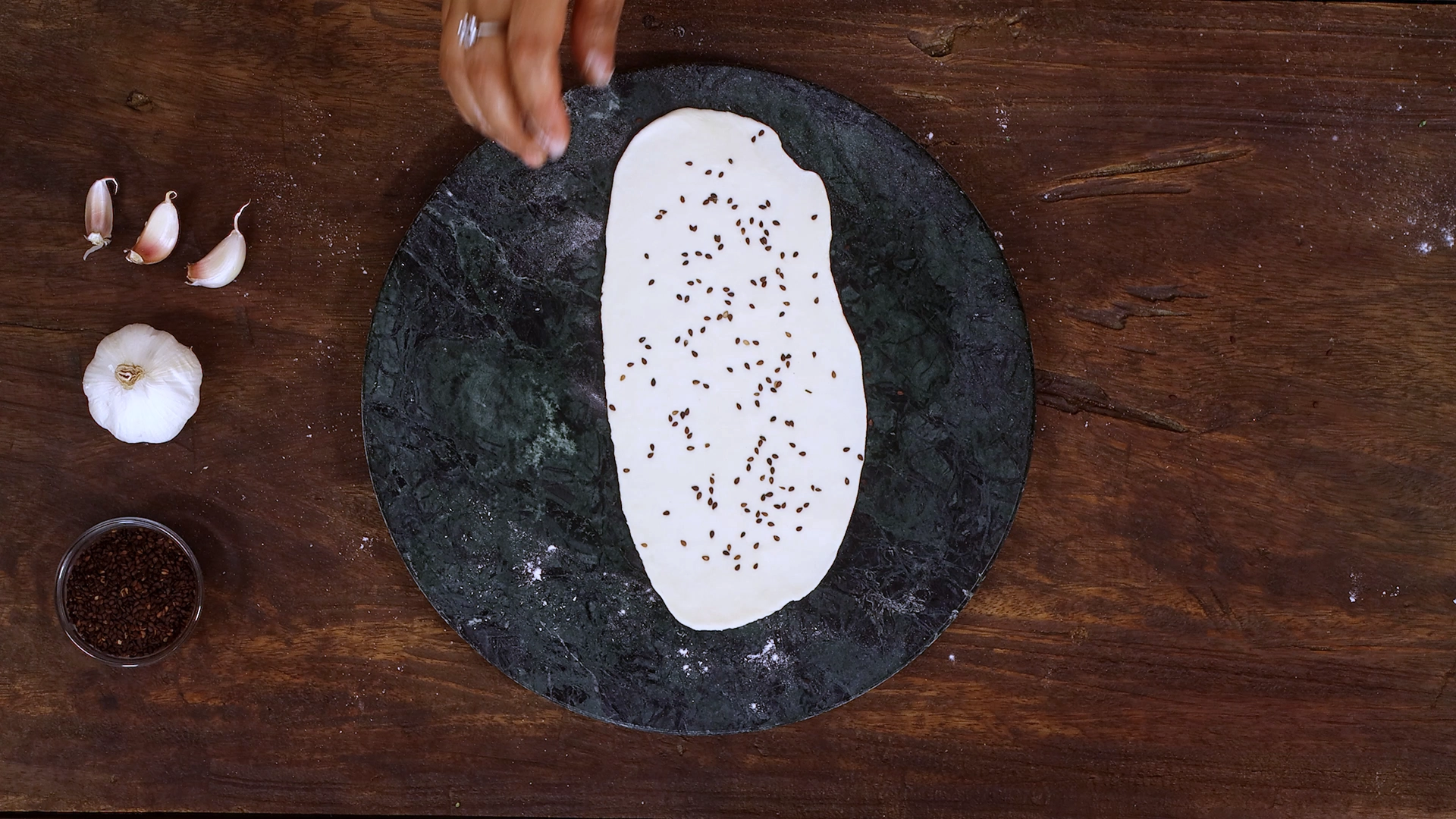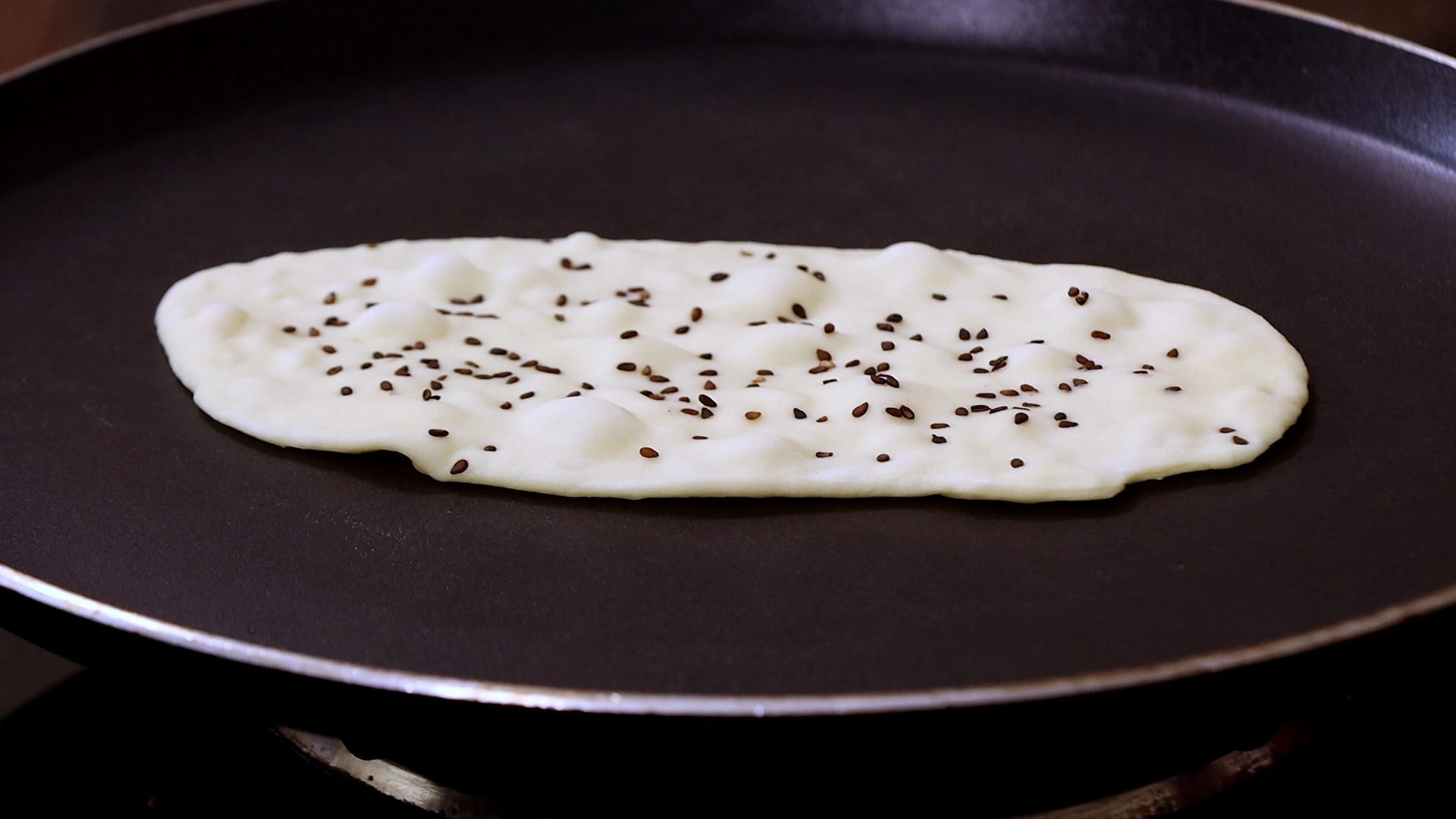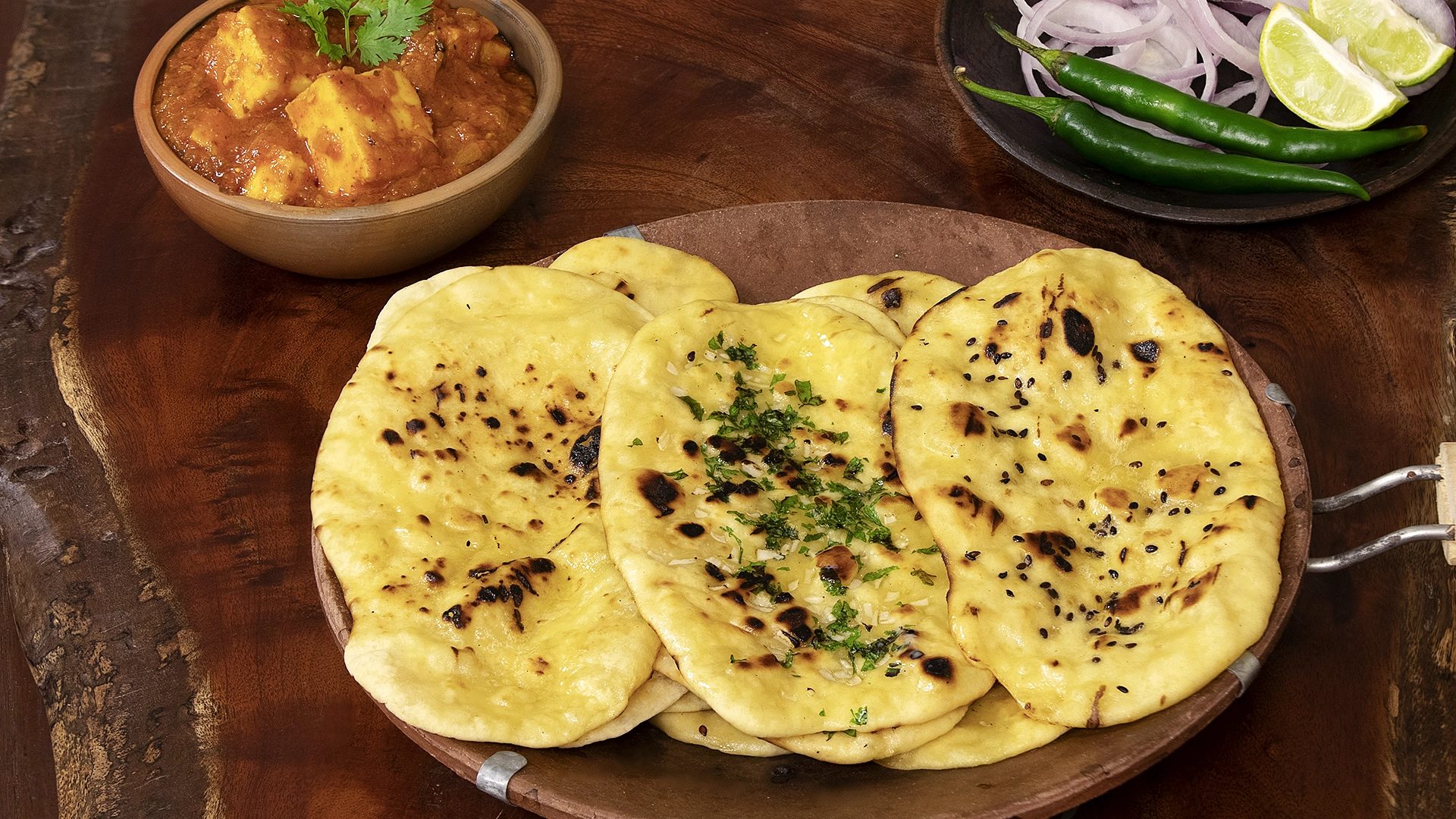Soft, pillowy, and beautifully charred, naan is one of the most beloved flatbreads in Indian cuisine. Whether paired with rich and creamy Paneer Butter Masala or a simple dal, naan has a way of elevating any meal.
Mughal Influence on Indian Cuisine
Naan may be synonymous with Indian cuisine today, but its origins trace back to Persia (modern-day Iran), where it was a popular flatbread baked in traditional clay ovens.
The word naan itself comes from the Persian language, meaning “bread.” It was introduced to India during the Mughal era when Persian and Central Asian influences significantly shaped royal kitchens.
The Mughals, known for their rich and elaborate feasts, brought techniques and dishes that forever transformed Indian cuisine. They introduced slow-cooked gravies, aromatic biryanis, and of course, soft, leavened breads like naan. In contrast to traditional Indian flatbreads like roti and chapati, which were made without leavening, naan was unique—it was enriched with yogurt, ghee, and sometimes even milk, making it softer and more indulgent.
Over time, naan became a staple in Mughal courts, often served with decadent dishes like korma, nihari, and butter-laden curries. As the recipe spread, it adapted to local tastes, giving rise to multiple variations—some topped with garlic and coriander, others sprinkled with sesame seeds, and many brushed generously with butter. Today, naan is enjoyed across India and beyond, a delicious reminder of the rich culinary exchange between Persia and the Indian subcontinent.
Ingredients That Make the Perfect Naan
Every ingredient in naan plays a crucial role in achieving its soft, fluffy, and slightly chewy texture, while also adding flavor. Here’s how each one contributes:
1. Maida (All-Purpose Flour)
This is the base of naan and gives it a soft and stretchy texture. Unlike whole wheat flour (atta), which makes denser bread like roti, maida ensures naan remains light and fluffy with a slight chewiness.
2. Baking Soda & Baking Powder
Since naan is traditionally made with yeast, baking soda and baking powder act as the leavening agents in this yeast-free version. They help the dough rise and develop air pockets, creating that signature soft and puffy texture.
3. Sugar
A small amount of sugar not only adds a hint of sweetness but also helps in activating the baking soda and baking powder. This ensures the naan turns out light and airy rather than dense.
4. Salt
Salt enhances the overall flavor and balances the slight sweetness of sugar. Without it, naan would taste bland.
5. Ghee
Ghee adds richness and moisture, giving naan its buttery softness. It also makes the dough easier to handle and helps achieve a more tender texture. Some people use butter, but ghee provides a more authentic flavor.
6. Curd (Yogurt)
Curd plays a key role in making naan soft and slightly tangy. It also helps tenderize the gluten, ensuring the naan doesn’t turn too chewy. Additionally, it aids in fermentation, improving the overall texture.
7. Hot Water
Instead of cold water, hot water is used to activate the leavening agents quickly. It also makes the dough more pliable and easier to knead, ensuring soft and fluffy naan.
8. Chopped Garlic (For Garlic Naan)
Garlic naan is a flavor-packed variation where finely chopped garlic is pressed into the dough before cooking. As it toasts, the garlic releases its natural oils, giving the naan a bold, slightly caramelized flavor.
9. Coriander Leaves
Fresh coriander leaves add a bright, herby freshness to garlic naan. They also enhance the overall aroma and presentation.
10. Sesame Seeds (For Sesame Naan)
These add a nutty crunch and subtle earthiness to the naan, making it different from the softer, plainer versions.
By combining these simple yet essential ingredients, you get a naan that is flavorful, soft, and slightly crisp on the edges, making it the perfect companion for rich curries and gravies!
The Secret to Soft Naan: The Dough & Resting Process
The foundation of a perfect naan lies in the dough, and the way you prepare and rest it makes all the difference.
Why Resting the Dough is Crucial
Once the dough is kneaded, it’s important to let it rest for at least an hour. During this time, several key things happen:
- Gluten Development:
Kneading activates the gluten in the flour, making the dough elastic and stretchy. But too much kneading can make it tight and difficult to roll. Resting allows the gluten to relax, making the dough softer and easier to shape without springing back. - Leavening Action:
Since we are using baking soda and baking powder instead of yeast, resting gives these agents time to work. They slowly release gas, making the dough light and airy, which creates those signature air pockets when the naan is cooked. - Moisture Absorption:
The ingredients—curd, ghee, and water—fully absorb into the flour during resting, making the dough more hydrated and pliable. This ensures the naan turns out soft, rather than dry or tough. - Flavor Development:
Resting enhances the taste and texture of naan. The curd slightly ferments the dough, giving it a mild tangy flavor similar to traditional naan made with yeast.
What Happens If You Skip Resting?
- The naan will lack softness and may turn out dense and chewy.
- The gluten won’t have time to relax, making it harder to roll and shape.
- The baking soda and powder won’t get enough time to activate, leading to a flat, lifeless naan with fewer air pockets.
By taking the time to rest the dough properly, you ensure naan that is soft, fluffy, and full of flavor—just like the ones from your favorite restaurant!
Making the Perfect Naan
Making naan at home is surprisingly simple. It starts with a basic dough—flour, baking soda, baking powder, sugar, salt, ghee, and curd—all kneaded together with warm water until smooth and elastic. After resting for an hour, the dough turns soft and pliable, making it easy to roll out.
Once the dough is divided, it’s time to get creative! Some naan gets a generous sprinkle of garlic and coriander, infusing it with a bold, aromatic flavor. Others are topped with black sesame seeds, adding a nutty crunch. And of course, there’s the classic butter naan—soft, warm, and brushed with melted butter for that irresistible glossy finish.
Cooking naan on a hot tawa or griddle brings out the best texture. It’s first roasted on both sides, and then for that authentic charred effect, it’s placed directly over the flame, where it puffs up beautifully with golden-brown spots. Finally, a generous brushing of butter makes each piece glisten, ready to be torn and dipped into your favorite curry.
Best Ways to Serve Naan
Freshly made naan is best enjoyed straight off the pan, but it can also be packed for lunch. If storing for later, wrap it in foil or a clean cloth to keep it soft.
A quick reheat on the stovetop or microwave will bring back its freshness. Pair it with butter-laden gravies, spiced lentils, or even a yogurt dip for a comforting meal.
With its versatile flavors and melt-in-your-mouth texture, naan is more than just bread—it’s a celebration of tradition and taste. Whether you love the bold flavors of garlic naan, the richness of butter naan, or the crunch of sesame naan, there’s always a version to suit every craving!
Naan Recipe – Garlic, Butter & Sesame
Ingredients
For the Naan Dough
For Toppings
Instructions
Prep Work (Common for All Naan Variations)
-
In a bowl, combine maida, baking soda, baking powder, sugar, and salt. Stir well.
-
Pour in ghee and curd, then mix until the mixture is crumbly.
-
Gradually add hot water and knead into a soft, smooth dough.
-
Cover the dough with a damp cloth and let it rest for an hour.
-
Divide the dough into equal-sized balls.
Method for Butter Naan
-
Roll each dough ball into an evenly thick circle.
-
Heat a tawa, place the rolled naan on it, and cook on both sides until light golden spots appear.
-
Move the naan to a direct wire rack, flipping until it gets dark spots and puffs up.
-
Brush butter generously over the hot naan.
-
Serve the warm, buttery naan with your favorite curries or dips.
Method for Garlic Naan
-
Roll each dough ball into an evenly thick circle.
-
Sprinkle finely chopped garlic and coriander leaves over the rolled-out naan. Gently press them in.
-
Heat a tawa, place the naan on it, and cook on both sides until light golden spots appear.
-
Move the naan to a direct wire rack, flipping until it gets charred spots.
-
Brush butter over the hot naan for extra flavor.
-
Enjoy your flavorful garlic naan with curries or dips.
Method for Sesame Naan
-
Roll each dough ball into an evenly thick circle.
-
Sprinkle sesame seeds over the rolled-out naan and gently press them in.
-
Heat a tawa, place the naan on it, and cook on both sides until light golden spots appear.
-
Move the naan to a direct wire rack, flipping until it gets dark spots.
-
Brush butter over the hot naan for extra richness.
-
Serve your nutty sesame naan warm with your favorite dishes.
Nutrition Facts
Servings 4
- Amount Per Serving
- Calories 220kcal
- % Daily Value *
- Total Fat 6g10%
- Saturated Fat 3g15%
- Cholesterol 10mg4%
- Sodium 310mg13%
- Potassium 60mg2%
- Total Carbohydrate 35g12%
- Dietary Fiber 1g4%
- Sugars 2g
- Protein 5g10%
- Calcium 40 mg
- Iron 2 mg
* Percent Daily Values are based on a 2,000 calorie diet. Your daily value may be higher or lower depending on your calorie needs.

